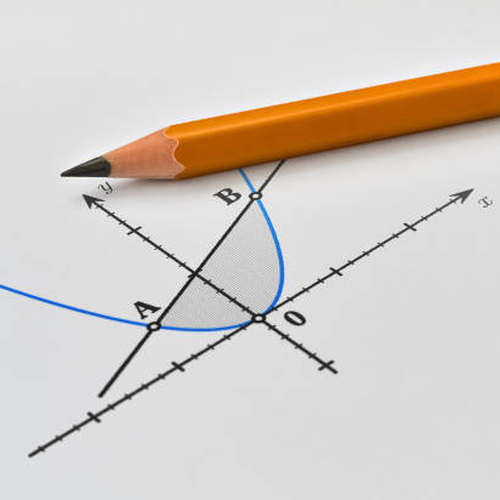What does it do?
This quadratics solver app uses matplotlib to graph a quadratic equation. This application also solves the equation in vertex form, solves for the roots, and solves for the vertex.
Source Code
# main.py
from equation import Equation, graph
def main():
# User input
while True:
try:
a = int(
input('What is the "a" value of your equation? (in standard form):\n')
)
b = int(input('"b" value? (in standard form):\n'))
c = int(input('"c" value? (in standard form):\n'))
break
except:
pass
# Equation class
equation = Equation((a, b, c))
standard_form = equation.get_standard_form()
vertex_form = equation.get_vertex_form()
a, b, c = equation.values
x1, x2 = equation.get_zeros()
x, y = equation.get_vertex()
print(
"""
[+] Standard Form = {}\n
[+] Vertex Form = {}\n
[+] 1st zero/root = {}\n
[+] 2nd zero/root = {}\n
[+] Vertex = {}\n
[+] AOS: x = {}""".format(
standard_form, vertex_form, x1, x2, (x, y), x
)
)
graph(equation)
if __name__ == "__main__":
main()
# equation.py
import math
import matplotlib.pyplot as plt
class Equation:
def __init__(self, values):
self.values = values
def get_zeros(self):
a, b, c = self.values
x = (b ** 2) - (4 * a * c)
x1 = (-b + math.sqrt(x)) / (2 * a)
x2 = (-b - math.sqrt(x)) / (2 * a)
return x1, x2
def get_vertex(self):
a, b, c = self.values
x = (-b) / (2 * a)
y = ((4 * a * c) - (b ** 2)) / (4 * a)
return x, y
def get_standard_form(self):
a, b, c = self.values
return "{}x^2 + {}x + {}".format(a, b, c)
def get_vertex_form(self):
a = self.values[0]
h, k = self.get_vertex()
return f"{a}(x-{h})^2 + {k}"
def graph(equation):
a, b, c = equation.values
r1, r2 = equation.get_zeros()
if r1 < r2:
x = r1
y = r2
else:
x = r2
y = r1
roots1 = []
roots2 = []
fig = plt.figure()
ax = fig.add_subplot(1, 1, 1)
# Set axes
# ax.spines['left'].set_position('center')
# ax.spines['bottom'].set_position('zero')
# ax.spines['right'].set_color('none') # remove vertical box line
# ax.spines['top'].set_color('none') # remove horizontal box line
# ax.xaxis.set_ticks_position('bottom')
# ax.yaxis.set_ticks_position('left')
while x < y:
base = float((a * (x ** 2)) + (b * x) + c)
roots1.append(x)
roots2.append(base)
x += 0.0001
plt.plot(roots1, roots2, "g")
plt.show()import math
import matplotlib.pyplot as plt
class Equation:
def __init__(self, values):
self.values = values
def get_zeros(self):
a, b, c = self.values
x = (b ** 2) - (4 * a * c)
x1 = (-b + math.sqrt(x)) / (2 * a)
x2 = (-b - math.sqrt(x)) / (2 * a)
return x1, x2
def get_vertex(self):
a, b, c = self.values
x = (-b) / (2 * a)
y = ((4 * a * c) - (b ** 2)) / (4 * a)
return x, y
def get_standard_form(self):
a, b, c = self.values
return "{}x^2 + {}x + {}".format(a, b, c)
def get_vertex_form(self):
a = self.values[0]
h, k = self.get_vertex()
return f"{a}(x-{h})^2 + {k}"
def graph(equation):
a, b, c = equation.values
r1, r2 = equation.get_zeros()
if r1 < r2:
x = r1
y = r2
else:
x = r2
y = r1
roots1 = []
roots2 = []
fig = plt.figure()
ax = fig.add_subplot(1, 1, 1)
# Set axes
# ax.spines['left'].set_position('center')
# ax.spines['bottom'].set_position('zero')
# ax.spines['right'].set_color('none') # remove vertical box line
# ax.spines['top'].set_color('none') # remove horizontal box line
# ax.xaxis.set_ticks_position('bottom')
# ax.yaxis.set_ticks_position('left')
while x < y:
base = float((a * (x ** 2)) + (b * x) + c)
roots1.append(x)
roots2.append(base)
x += 0.0001
plt.plot(roots1, roots2, "g")
plt.show()
Ensure both files are in the same project directory. Run python main.py to start the application.
